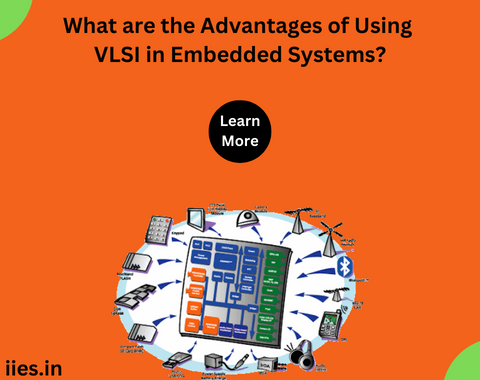
Embedded systems have become an integral part of our daily lives, seamlessly integrating into various devices we use, from smartphones and smart appliances to automotive control systems and medical devices. One of the key enablers behind the efficiency and compactness of these embedded systems is Very Large Scale Integration (VLSI) technology. VLSI involves packing thousands, or even millions, of transistors onto a single chip, providing numerous advantages that contribute to the success and widespread adoption of embedded systems.
One of the primary advantages of using VLSI in embedded systems is the significant reduction in size and power consumption. VLSI allows the integration of complex functionalities into a single chip, eliminating the need for multiple components and their associated interconnections.
Size and Power Efficiency
This reduction in components and interconnects not only shrinks the physical size of the embedded system but also leads to lower power consumption, making it ideal for battery-operated devices.
High Performance
VLSI technology facilitates the integration of a large number of transistors and other components onto a single chip, enabling the development of high-performance embedded systems. The dense integration of components allows for faster processing speeds, efficient data handling, and quick response times. This is particularly crucial in applications such as real-time control systems, where rapid and accurate decision-making is essential.
Cost-Effectiveness
Despite the initial development costs associated with VLSI design, the mass production of integrated circuits using VLSI technology results in significant cost savings. Once the design is finalized and the manufacturing process is established, the cost per unit decreases substantially. This cost-effectiveness has played a crucial role in the widespread adoption of VLSI in embedded systems, making advanced technologies more accessible and affordable for various applications.
Reliability and Durability
The integration of components on a single chip reduces the number of solder joints and interconnections, minimizing the chances of failures due to physical wear and tear. Additionally, VLSI technology allows for the implementation of error-checking and correction mechanisms on the chip, enhancing the reliability of embedded systems. The durability of VLSI-based embedded systems is particularly advantageous in mission-critical applications such as medical devices and aerospace systems.
Integration of Multiple Functions
VLSI enables the integration of multiple functions and features onto a single chip, providing a versatile platform for diverse applications. This integration not only reduces the overall system complexity but also enhances the functionality of embedded systems. For example, a single VLSI chip can house a microcontroller, memory, communication interfaces, and sensor interfaces, streamlining the design and development process.
Scalability
VLSI-based embedded systems offer scalability, allowing designers to add or remove functionalities as needed. This flexibility is crucial in adapting to changing requirements and technological advancements. Whether it’s adding new sensors, communication protocols, or processing capabilities, VLSI technology provides a scalable platform that can evolve with the demands of the application.
Energy Efficiency
Energy efficiency is a critical consideration in the design of embedded systems, especially for battery-powered devices. VLSI design allows for the implementation of power-saving techniques such as clock gating, power gating, and dynamic voltage and frequency scaling. These techniques optimize power consumption by selectively powering down or adjusting the operating parameters of specific components based on the system’s workload, contributing to longer battery life and reduced energy consumption.
Ease of Prototyping and Manufacturing
The development of VLSI-based embedded systems benefits from advancements in design tools and methodologies. Designers can use sophisticated software tools for simulation, verification, and prototyping, enabling faster and more efficient development cycles. Additionally, the standardized manufacturing processes for VLSI chips contribute to a streamlined production pipeline, reducing time-to-market and overall development costs.
Advanced Signal Processing and Sensing
VLSI technology enables the implementation of sophisticated signal processing algorithms directly on the chip, enhancing the capabilities of embedded systems in processing and interpreting data. This is particularly crucial in applications such as image and audio processing, where real-time analysis and response are essential. Advanced signal processing capabilities allow embedded systems to extract meaningful information from various sensors, enabling applications like facial recognition, voice commands, and environmental monitoring.
Security and Encryption
In an era where data security is paramount, VLSI-based embedded systems provide the foundation for implementing robust security features. Encryption algorithms and secure key storage can be integrated directly into the chip, safeguarding sensitive data from unauthorized access. The inherent complexity of VLSI designs also contributes to making it challenging for attackers to reverse engineer or tamper with the embedded system, enhancing the overall security posture of the device.
Rapid Innovation and Time-to-Market
The modular and scalable nature of VLSI-based embedded systems accelerates the innovation cycle. Designers can focus on specific functionalities without being encumbered by the intricacies of hardware integration, leading to faster prototyping and development. This speed-to-market advantage is particularly crucial in industries where staying ahead of the competition and responding quickly to evolving consumer demands are essential.
Internet of Things (IoT) Integration
As the Internet of Things continues to expand, VLSI technology plays a pivotal role in enabling the seamless integration of embedded systems into IoT networks. The compact size and energy efficiency of VLSI-based devices make them well-suited for deployment in IoT applications. These embedded systems can efficiently collect, process, and transmit data, contributing to the interconnected world of smart devices and enhancing the overall efficiency of IoT ecosystems.
The advantages of using VLSI in embedded systems are undeniable, revolutionizing the landscape of technology and driving innovation across various industries. From the miniaturization of devices to improvements in performance, reliability, and energy efficiency, VLSI technology continues to play a pivotal role in shaping the capabilities of embedded systems. As the demand for smarter, more compact, and energy-efficient devices continues to grow, the integration of VLSI will remain a key enabler, propelling the development of advanced embedded systems into the future.
Indian Institute of Embedded Systems – IIES